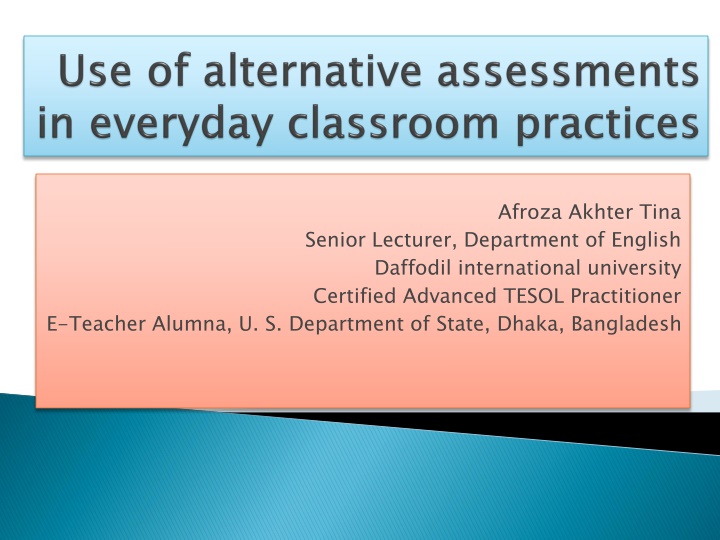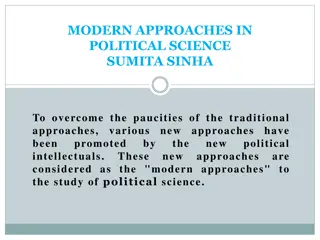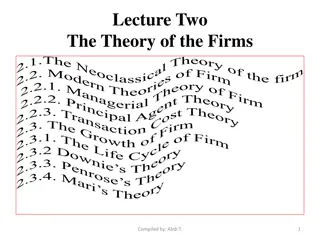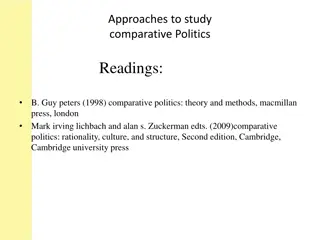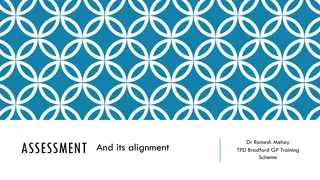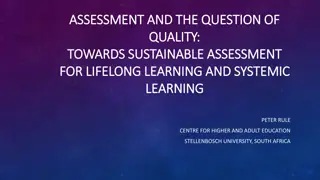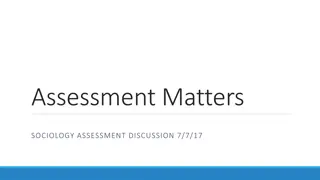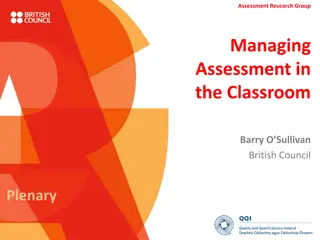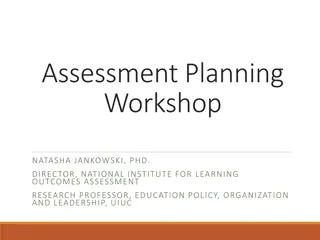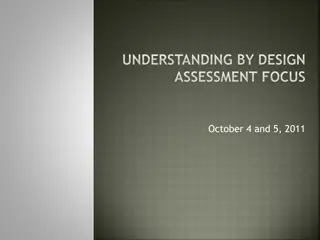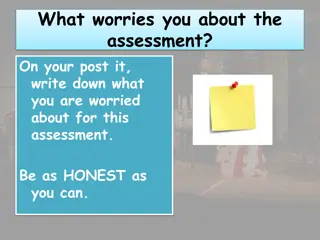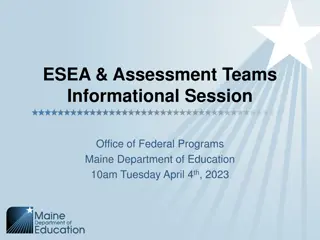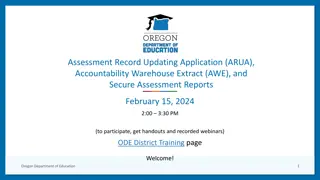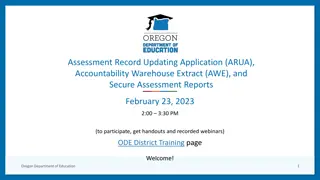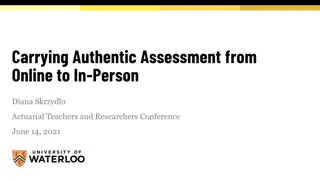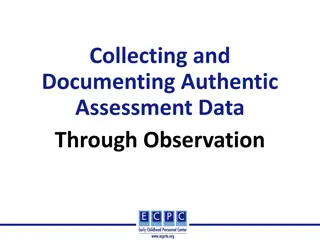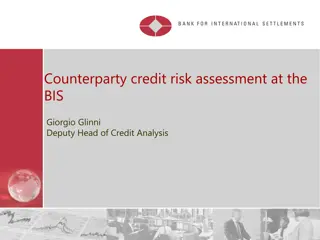Modern Approaches to Assessment in Education
Explore innovative methods such as alternative assessments and traditional tools that focus on students' growth and performance in the educational sector. From performance tasks to individual assessment cards, this comprehensive overview highlights diverse strategies used to evaluate students' knowledge and skills effectively.
Download Presentation

Please find below an Image/Link to download the presentation.
The content on the website is provided AS IS for your information and personal use only. It may not be sold, licensed, or shared on other websites without obtaining consent from the author.If you encounter any issues during the download, it is possible that the publisher has removed the file from their server.
You are allowed to download the files provided on this website for personal or commercial use, subject to the condition that they are used lawfully. All files are the property of their respective owners.
The content on the website is provided AS IS for your information and personal use only. It may not be sold, licensed, or shared on other websites without obtaining consent from the author.
E N D
Presentation Transcript
Afroza Akhter Tina Senior Lecturer, Department of English Daffodil international university Certified Advanced TESOL Practitioner E-Teacher Alumna, U. S. Department of State, Dhaka, Bangladesh
Alternative assessments performance on tasks that require extended time, complex thinking, and integration of subject matter learning (Baker & Linn, 1990; Shavelson, 1990; Torney-Purta, 1990). It determines do, in contrast to what they do or do not know Alternative assessments focus on students' determines what students can and cannot
Traditional assessment to display their knowledge in a predetermined way (Brualdi, 1996)- BEFORE MOOC Traditional assessment tools require learners Alternative assessments growth and the performance of the student Alternative assessments tools focus on the
5-week online teacher training course on Art of Everyday Classroom Assessment of English Language Learners Art of Everyday Classroom Assessment of English Language Learners 5-week AE E Assessment of English Language Learners AE E- -Teacher Orientation Course Assessment of English Language Learners Teacher Orientation Course on
Plot a family tree. Conduct an interview. Create an info graphic. Write a how-to manual. Present opposite points of view. Produce a multimedia, interactive poster. Design a travel brochure. Reflection Diaries.
Dramatization Gathering real-world examples. Portfolio assessment Observation based assessment Questionnaires and surveys Assessment Cards
E- Reflection diaries Portfolios
Individual Assessment Cards Individual Assessment Cards Progressive I Statements Progressive I- -Can Statements Can Instant Feedback for Learner Training Promoting Learner Confidence
Portfolio grade students' work using rating scale than numerical or letter scores. ... The interactiveness of portfolio assessment relationship between student-student, teacher-student, and teacher-parent. Portfolio, is used to assess assess, evaluate and portfolio assessment encourages and developes
E E- -portfolios assessment alternative, which can provide a more flexible, less cumbersome, and longer- term record of a student s development or a program s performance. Portfolio assessment reflect their real performance, to show their weak and strong domain and to observe student's progress during the learning process, and encourages students to take responsibilities for their own learning. portfolios have emerged as an important Portfolio assessment enables students to
Files of various formats (texts, pictures, videos, etc.) Writing samples (which might include several drafts to show development and improvement) Projects prepared for class Homework and Class work Extracurricular activities
Writing the diaries requires the students to reflect on the followings: the teaching and learning activities that have taken place provides opportunity for them to search for and express their learning in a personal way to relate and apply their learning to their own teaching and assessment practice
Students will be actively engaged to the learning process It may increase students interests, empower them to be more responsible to their own learning and more reflective in their study They may share ideas through speaking if can encourage them
1. Build-up feedbacks on their works 2. Documentation
Clive Lovelock, an English teacher at a Japanese university, developed this process of assessment in 1996. The purpose was to make students learn basic communication skills and also develop learning skills.
obtaining, storing, retrieving, and using language social active involvement in the learning process Assessme nt Cards strategies and communicatio n strategies consciousne ss raising
At the beginning, students read an explanation in English about the strategies listed on the card and why they should use them. In every class an activity lasts from 10 to 15 minutes and is an easy way for students to collect points. It s important to set a maximum score based on the cards.
Its Khadija AlHayki, and Caroline Linse to build students confidence in their ability to write in English. Creating opportunities for students to state what they perceive they are able to do which can be referred to as I-can statements , such as I can write about daily activities in English. a strategy developed by Fife MacDuff,
Teachers can present a single I-can statement associated with a task and have students write or say the statement when they complete that task. Another option is to begin activities by presenting a list of I-can statements that students can copy, check off, and read out loud as they progress through an activity. Depending on students ability levels, the teacher can present I-can statements in scrambled order and have students number the statements as they complete each task or at the end of the activity. Students at a more advanced stage of learning may even offer to add I-can statements that the teacher had not originally included. Another statements as I-will statements before beginning an activity or unit. alternative is to present the I-can
Comparing Athens and Sparta: Where Would You Rather Live, and Why? After argumentative essay. Assess your writing with the help of I-can statements - (to develop their self-esteem) reading the handout, write an
Write arguments to support claims in an analysis of substantive topics or texts, using valid reasoning and relevant and sufficient evidence. a. Introduce precise claim(s), distinguish the claim(s) from alternate or opposing claims, and create an organization that establishes clear relationships among claim(s), counterclaims, reasons, and evidence. b. Develop claim(s) and counter claims fairly, supplying evidence for each while pointing out the strengths and limitations of both in a manner that anticipates the audience s knowledge level and concerns. c. Use words, phrases, and clauses to link the major sections of the text, create cohesion, and clarify the relationships between claim(s) and reasons, between reasons and evidence, and between claim(s) and counterclaims. d. Establish and maintain a formal style and objective tone while writing. e. Provide a concluding statement or section that follows from and supports the argument presented.
Level 3: I can write text. I can support evidence. I can write an argument to support a claim after reading a I can support claims from a text with reasons and Level 2: I can choose a text. I can choose evidence. I can choose an argument to support a claim after reading I can choose claims from a given text with reasons and Level 1: I can identify a text. I can identify evidence. I can identify an argument to support a claim after reading I can identify claims from a given text with reasons and
Harder to evaluate Process can be costly in terms of time, effort, equipment, materials, facilities, or funds. Rating process is sometimes more subjective than traditional exams. Inaccurate reflection of student progress and knowledge.
Noting down the significant points (regarding the lesson/teaching) Improvising the lesson plan (if needed) Improving teaching (on the basis of feedback)
Questions??? Questions???
